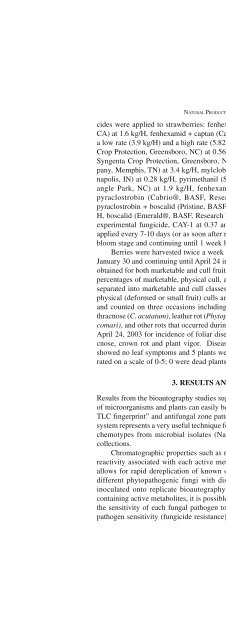Allelochemicals Biologica... - Name
Allelochemicals Biologica... - Name
Allelochemicals Biologica... - Name
You also want an ePaper? Increase the reach of your titles
YUMPU automatically turns print PDFs into web optimized ePapers that Google loves.
NATURAL PRODUCT BASED FUNGICIDES 7<br />
cides were applied to strawberries: fenhexamid (Elevate®, Arvesta, San Francisco,<br />
CA) at 1.6 kg/H, fenhexamid + captan (CaptEvate®, Arvesta, San Francisco, CA) at<br />
a low rate (3.9 kg/H) and a high rate (5.82 kg/H), azoxystrobin (Quadris®, Syngenta<br />
Crop Protection, Greensboro, NC) at 0.56 kg/H, cyprodinil + fludioxonil (Switch®,<br />
Syngenta Crop Protection, Greensboro, NC) at 0.8 kg/H, captan (Micro Flo Company,<br />
Memphis, TN) at 3.4 kg/H, mylclobutanil (Nova®, Dow AgroSciences, Indianapolis,<br />
IN) at 0.28 kg/H, pyrimethanil (Scala®, Bayer CropScience, Research Triangle<br />
Park, NC) at 1.9 kg/H, fenhexamid at 1.68 kg/H + captan at 3.4 kg/H,<br />
pyraclostrobin (Cabrio®, BASF, Research Triangle Park, NC) at 0.20 kg/H,<br />
pyraclostrobin + boscalid (Pristine, BASF, Research Triangle Park, NC) at 0.62 kg/<br />
H, boscalid (Emerald®, BASF, Research Triangle Park, NC) at 0..59 kg/H, and the<br />
experimental fungicide, CAY-1 at 0.37 and 0.74 kg/H. Fungicide treatments were<br />
applied every 7-10 days (or as soon after rainfall as possible) starting at or near fullbloom<br />
stage and continuing until 1 week before harvesting ceased.<br />
Berries were harvested twice a week throughout the entire season beginning on<br />
January 30 and continuing until April 24 in 2003. Total fruit count and weights were<br />
obtained for both marketable and cull fruits, along with average weight per berry and<br />
percentages of marketable, physical cull, and diseased cull fruit per acre. Fruit were<br />
separated into marketable and cull classes, with the culls being further divided into<br />
physical (deformed or small fruit) culls and diseased culls. Diseases were identified<br />
and counted on three occasions including berries with gray mold (B. cinerea), anthracnose<br />
(C. acutatum), leather rot (Phytophthora cactorum), stem end rot (Gnomonia<br />
comari), and other rots that occurred during the picking season. Plants were rated on<br />
April 24, 2003 for incidence of foliar disease, number of dead plants due to anthracnose,<br />
crown rot and plant vigor. Diseases were rated on a scale of 0-5; 0 plants<br />
showed no leaf symptoms and 5 plants were completely defoliated. Plant vigor was<br />
rated on a scale of 0-5; 0 were dead plants and 5 were extremely vigorous plants.<br />
3. RESULTS AND DISCUSSION<br />
Results from the bioautography studies suggest that chemically different populations<br />
of microorganisms and plants can easily be distinguished by their characteristic “2D-<br />
TLC fingerprint” and antifungal zone patterns (Wedge and Nagle, 2000). Thus, this<br />
system represents a very useful technique for the identification and selection of unique<br />
chemotypes from microbial isolates (Nagle and Paul, 1999) and plant extract(?)<br />
collections.<br />
Chromatographic properties such as relative polarity, UV absorbance, chemical<br />
reactivity associated with each active metabolite provide valuable information that<br />
allows for rapid dereplication of known or nuisance compounds. When strains of<br />
different phytopathogenic fungi with dissimilar fungicide resistance profiles are<br />
inoculated onto replicate bioautography plates prepared from any given extract<br />
containing active metabolites, it is possible to visually observe distinct differences in<br />
the sensitivity of each fungal pathogen to single metabolites. These differences in<br />
pathogen sensitivity (fungicide resistance) can be observed by direct comparison of


